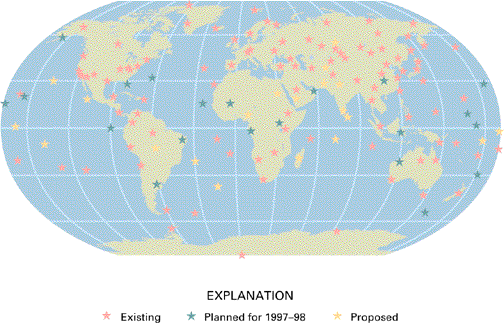
Highlight 4--The Global Seismographic Network
The USGS has operated seismographic stations throughout the world for more than 35 years and has recently upgraded the system to create a state-of-the-art Global Seismographic Network (GSN) in cooperation with the Incorporated Research Institutions for Seismology (IRIS), a consortium of more than 90 U.S. universities. The GSN is jointly funded by the USGS, the National Science Foundation, and the U.S. Air Force. When completed, the GSN will include 151 stations in more than 80 countries (fig. 4). By the end of 1996, 107 stations were operational. The USGS is responsible for operating 77 of these. This seismographic network, with rapid online access, advances understanding of the physical world. The GD uses GSN data for rapid earthquake reporting--accurate location and depth are available within an hour for significant earthquakes, generally magnitude 5.5 or greater, anywhere in the world-- and for earthquake, tsunami, and volcano hazard research and warnings. In addition, 51 GSN stations are part of the International Monitoring System, which confirms the end of nuclear weapons testing. Every day, dozens of universities access global seismographic data for researching and teaching about the structure of the Earth's interior.

Figure 4. Locations of some of the stations in the Global Seismographic Network. From Lane and Eaton (1997).
<----- Back to Working with Others
This page is <https://pubs.usgs.gov/circular/c1172/h4.html>
Maintained by L. McElroy
Last updated 04.08.98

